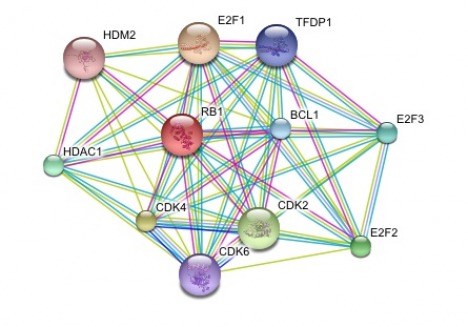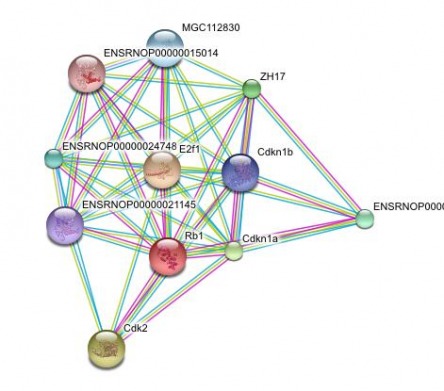This web page was produced as an assignment for Genetics 677, an undergraduate course at UW-Madison
Protein Interactions
| proteininteractionscore1.jpg | |
| File Size: | 132 kb |
| File Type: | jpg |
The protein interaction map that was generated using SMART gave expected and unsurprising results. RB1 had the strongest interactions with E2F1 and E2F2 proteins, as well as with CDK2, CDK4, and CDK6, and histone deacetylase 1 (HDAC1). (1),(3)
E2F1 and E2F2 are transcription factors that are involved with cell cycle control and in the action of tumor suppressor genes. It makes sense that RB1 is associated with these two transcription factors because the RB1 protein contains a cyclin domain, which is a part of the maturation promoting factor (MPF), which is also involved in cell cycle control. (2)
The cyclin dependant kinases (CDKs) that the RB1 protein is associated with (CDK2,4, and 6) are also associated cell cycle control, specifically the cell cycle G1 phase progression. As RB1 is also a cyclin dependant protein, it would be expected that the two would be related, and that is what has been found. (1),(2)
HDAC1 is a protein that, together with RB1, provide a key point of control over cell proliferation and differentiation.
When looking at the full protein interaction list in the figure above, it can be seen that the interaction scores for the list of proteins are all at 0.999, meaning they all interact at a high level. The level at which RB1 interacts with its related proteins, as well as the role these interacting proteins play in the important process of growth and differentiation displays the importance and necessity for a well functioning RB1 protein. (1)
Protein Interactions in Rb1 homolog: The Rat
| rb1ratchart.jpg | |
| File Size: | 77 kb |
| File Type: | jpg |
References
1. String http://string.embl.de/newstring_cgi/show_network_section.pl
2. Retinoblastoma: the disease, gene and protein provide critical leads to understand cancer. DiCiomma D. et al. seminars in CANCER BIOLOGY, Vol. 10, 2000: pp. 255–269
3. SMART, http://smart.embl-heidelberg.de/smart/show_motifs.pl
4. Figure 1, 2: String, http://string.embl.de/newstring_cgi/show_network_section.pl




